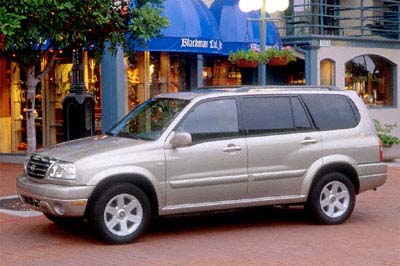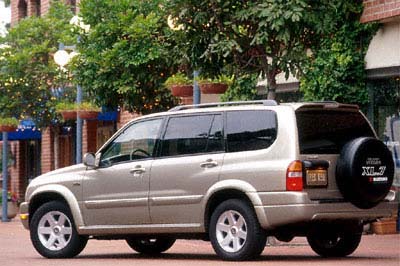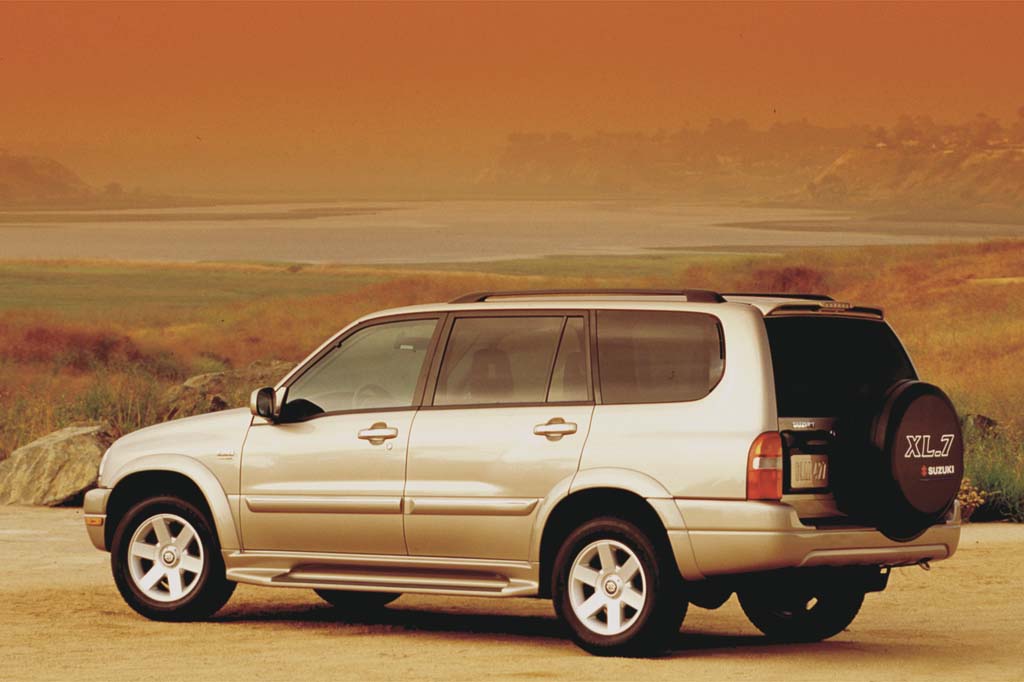| Midsize SUV; Built in Japan |
|
|
| Good condition price range: $2,400 – $8,900* |

2001 Suzuki XL-7

2001 Suzuki XL-7

2001 Suzuki XL-7 interior

2002 Suzuki XL-7

2002 Suzuki XL-7
| Pros: |
|
| Cons: |
|
Prices might have seemed attractive when the XL-7 was new, but these SUV’s were no bargain given their subpar refinement, labored acceleration, stiff and nervous ride, poor handling, and antiquated 4WD system. Basically, this is a mediocre compact SUV, stretched to become a mediocre midsize SUV, with a cramped third-row seat of questionable usefulness being its sole asset.
Overview
Introduced during the 2001 model year, Suzuki’s newest and biggest midsize sport-utility vehicle was basically the compact Grand Vitara wagon, with a 12.6 inch longer wheelbase and 19.1 inches of added length. Capable of seating seven passengers, the XL-7 used a larger version of the Grand Vitara’s V6.
Manual and automatic transmissions were available. The XL-7 came with either rear-wheel drive or four-wheel drive. Its 4WD system had to be disengaged on dry pavement, but included low-range gearing.
Four models were offered: Standard, Plus, Touring, and Limited. Antilock braking was standard on Touring and Limited models. Roof rails could hold 100 pounds of cargo.
Measuring 183.7 inches overall, the XL-7 was 10 inches longer than a Ford Escape and 6 inches longer than Honda’s CR-V. According to Suzuki, rear doors were 8 inches wider at the base and a foot wider at the top, compared to other SUVs in this class. Second-row seats adjusted fore and aft. With second- and third-row seats down, cargo volume totaled 73 cubic feet. A full-size spare tire was mounted on the back door.
Standard equipment included air conditioning, keyless remote entry, power windows/locks/mirrors, cruise control, a tilt steering wheel, and rear wiper/washer. The Plus model added rear air conditioning, 16-inch aluminum wheels, and an in-dash CD player. Touring editions got a sunroof, fog lamps, and a rear spoiler. Leather upholstery and running boards were included with the Limited. Competitors included such midsize models as the Ford Explorer, GMC Envoy, and Toyota Highlander.
Yearly Updates
| 2002 XL-7 More power and revised equipment were the big changes for 2002. The XL-7’s V6 engine gained 13 horsepower. A LATCH rear child-seat anchor system was installed. For 2002, the Standard model switched to five-passenger seating, losing its third-row seat. Other versions stuck with seven-passenger seating. Standard and Plus 4WD models now came with antilock braking, and all 4WD versions gained heated door mirrors. The XL-7 Limited added a leather-wrapped steering wheel and shift knob, woodgrain plastic console trim, and optional heated front seats. |
| 2003 XL-7 Standard and Plus models were dropped for 2003, leaving only Touring and Limited editions. Five-passenger seating was standard, with a third-row seat optional, including rear air conditioning. |
| 2004 XL-7 The 4-speed automatic was upgraded to a 5-speed unit and the model lineup was trimmed to just the LX and EX. |
| 2005 XL-7 Suzuki’s midsize SUV gets a tire-pressure monitor and new model names for 2005. XL-7 is basically a stretched version of Suzuki’s compact Grand Vitara, with a 12.6-inch-longer wheelbase, 22.9 inches of added length, and a larger 2.7-liter V6. |
| 2006 XL-7 There were no changes for the 2006 XL-7. |
